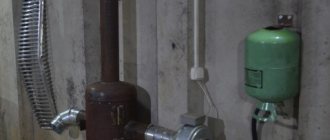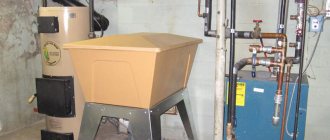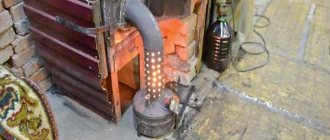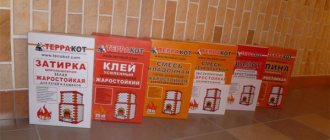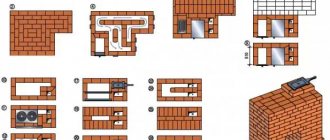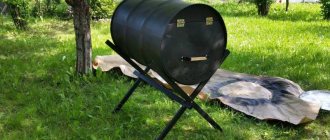What problems do owners of domestic buildings often face: garages, outbuildings, bathhouses, small swimming pools, summer kitchens? Indeed, in addition to carrying out a number of communications, it is necessary to deal with heating and heating. For those who have made a gas stove with their own hands, issues can be resolved simply and cheaply.
Anyone can buy special heating equipment. However, its cost is painful. Not many people are willing to spend large sums of money on the design and installation of a heating system in this kind of premises.
We will tell you how to assemble and run an effective and inexpensive heat generator in commercial buildings with your own hands. The home-made structures we offer, made according to pre-developed drawings, are easy to install and inexpensive. The information is confirmed by practice.
Types of gas furnaces
Devices can be of three types:
- Heating (gas stove for heating);
- Heating (designed to supply the room with hot water);
- Household (designed for a cauldron, performing the function of a bread maker, a source of heating for spacious rooms).
For example, a gas sauna stove is often installed with a heating and heating system; it can be lined with various materials, equipped with any type of burner, and is also made using different technologies and with various methods of heating water in containers.
Gas-wood boiler
For those who cannot imagine visiting a steam room without the unique smell of burning wood and want to save on the operation of the bathhouse, a gas-wood stove may be the ideal solution.
Such a heating device is a modern universal design that allows the use of various types of fuel: natural and liquefied gas, coal and wood. This is possible due to the fact that such stoves have removable elements necessary for working on solid fuel and gas.
Devices designed for gas combustion consist of burners, filters and various valves. At the same time, to operate a solid fuel stove you need a fuel receiver. Such heating devices are not new on the modern market. They were used back in Soviet times. A striking example of this is the OGV (heating gas water heating) boiler.
The equipment necessary for gas combustion is installed in the ash pan of the furnace. If it is dismantled, the boiler will function properly using solid fuel.
Gas-wood stoves are very popular not only due to their versatility. Their cost is at an acceptable level, which is an important factor for bathhouse owners.
pros
At the stage of modern economic development, gas is one of the most profitable and efficient types of fuel with high efficiency. The use of gas is particularly cost effective.
Today there are many different energy sources available on the market, despite this, a DIY gas stove remains popular and fully competes with factory-made products.
The advantages of using these devices include:
- Quickly, efficiently and efficiently heat the room to the desired temperature;
- Compact size and mobility (you can quickly move the stove to any place) due to the absence of a firebox and ash pan;
- No need for constant care;
- By installing a water tank, you can heat the water;
- Low resource consumption;
- Independence from public communications and other factors, which eliminates interruptions in work.
Best models
There are a large number of gas-fuelled sauna stoves on sale.
Most of them are domestically produced, and this is no coincidence - imported designs do not work well in our conditions. They need a stable supply of electricity, since almost all designs are supercharged. In addition, spare parts and replacement units for such furnaces are too expensive, which sharply reduces user interest.
Domestic furnaces are designed taking into account technical conditions and operating features. They are relatively cheap and unpretentious, have stable parameters, are durable and reliable. Therefore, user interest is focused specifically on domestic equipment.
Let's study the rating of the most popular models of gas stoves for baths:
Kutkin G-4.0
Oven with a power of 40 kW, weighing 85 kg (without stones). Capable of heating a heater weighing 120 kg. Designed for rooms with a volume of 40-75 m3.
- Pros - economical fuel consumption, the presence of 4 operating modes, the ability to adjust air convection without over-drying, heating the heater from 5 sides.
- Disadvantages - narrow range of burner settings, possibility of overheating of the stove (the housing material is not designed for long-term operation at maximum conditions), no steam generator.
Troika No. 06-GT80
Special design with a closed heater. This allows for maximum heating without loss of thermal energy. The furnace power is 80 kW, designed for use in a room with a volume of 40-70 m3.
- The advantages of the stove are high power and the ability to remain heated for a long time, no danger of getting burns from the hot body, no overheating and no drying out of the air.
- Disadvantages - heavy weight, requiring the manufacture of your own foundation, mandatory brick lining, large oven size.
Ermak Uralochka 30
Modular oven with a power of 30 kW, designed to operate in rooms with a volume of 24-30 m3. The 4mm thick body ensures durable and stable performance. The maximum weight of the heater is 110 kg (recommended - 70 kg).
- Pros : energy independence, intense air heating, ability to obtain dry and wet steam.
- Disadvantages - the resource of the water tank is relatively small, the weight of the stove is too large.
Teplodar Sahara-16
An efficient oven with a power of only 26 kW. At the same time, it is capable of heating a steam room with a volume of 8-16 m3 in 30 minutes to a temperature of 110 °C. The design is well thought out, the operation of the furnace in all modes is stable and trouble-free.
- The advantages of the stove are a multi-mode type of operation, the presence of wood power in parallel with a gas burner, the possibility of remote control, and compactness.
- Disadvantages - lack of a steam generator; the furnace lining wears out before the structure itself.
Izistim Yalta 35
A high-quality stove capable of long-term conservation of thermal energy even after shutdown. Capable of heating a bathhouse with a volume of 30-40 m3 in 1 hour 50 minutes (in winter, 30 minutes faster in summer). Power - 40 kW.
- The advantages of the stove are its durability, large heater, and a built-in steam generator.
- Disadvantages : heavy weight, limited fuel burning time to 10 hours.
Only the most popular models according to online stores are considered. The range of gas stoves is much wider; there are many alternative offers. When choosing a suitable stove, you should first consider its characteristics.
It is not advisable to be guided by popularity or position in the ranking - often such indicators do not correlate well with the true qualities of the equipment.
Flaws
Gas furnaces have their own disadvantages, including:
- Mandatory access to a gas source;
- The use of fuel has certain restrictions according to standards;
- In some cases, you will have to obtain certain agreements and permits from government agencies and gas services, especially for non-residential premises;
- It is necessary to design the installation, which is quite expensive;
- Compliance with special safety measures.
To achieve the highest efficiency from a gas furnace, the room must be equipped with protective screens. They have surfaces that do not allow warm air to escape, but reflect it, heating the required space.
When using open-type burners, it is necessary to additionally design and install a ventilation system, chimney and provide air humidification. The latter are necessary because the gas burns oxygen, as a result of which the air becomes dry, which leads to pain in the head and throat.
Gasification of the bathhouse
To ensure the full functioning of the constructed stove, it is necessary to take care of the gasification of the sauna. To do this, you should either purchase a cylinder unit or supply propane from a centralized system.
It is possible to provide a bathhouse with an uninterrupted supply of fuel for many years by cutting into the main network passing through the site. However, to carry out such a labor-intensive event, permission from the appropriate authority will initially be required. After this, you need to spend time and money on the following procedures:
- preparation of a number of necessary papers;
- acquisition of materials and equipment;
- inviting specialists to install the installation;
- preparation of test and technical documentation and delivery of work to the gas service at the location of the site;
- cutting into the citywide system;
- installation and registration of a gas meter;
- obtaining documents for payment for gas supply services.
Gas furnace design
The design of a gas stove is similar to a model heated with solid fuel, with the exception of some features.
The oven consists of:
- Housings;
- Thermostat;
- Fuse (to shut off the gas supply during extinguishing);
- Sealed gas chamber;
- Chimney.
The difference is that the fuel is supplied through a supplied line, which is a special flexible hose connected to the burner.
In some cases, a balloon is used. It is placed in a special container in compliance with all safety regulations. A five-cc gas cylinder is capable of heating a room of up to 200 m2 during one heating season.
The air supply to gas equipment is adjusted using a door located below, which does not interfere with cleaning the burner.
How to calculate gas consumption?
To calculate gas consumption, you need to know the power of the stove and the heated area. When choosing the power of the furnace, adhere to the following rule: for every 10 square meters of heated area, 1 kW of unit power is required. It is advisable to purchase a device with a power reserve of 20%.
After determining the power, fuel consumption can be calculated. To provide 1 kW of thermal power of the device, it is necessary to consume 0.112 cubic meters of gas. In other words, to heat a room with an area of 20 square meters for one hour you need 2 x 0.112 = 0.224 cubic meters of fuel. Knowing this number, you can calculate the daily fuel consumption, as well as the need for it for the entire heating season.
Options
Before you start making a gas stove with your own hands, you need to decide on its parameters, such as:
- Material of manufacture;
- Burner type;
- Location of the water tank.
What should a chimney look like?
When connecting chimneys to gas equipment, the following recommendations must be observed:
- The chimney can operate no more than two appliances. If two gas units are switched, they must be placed at different levels relative to each other at a distance of 50 cm.
- If both devices are located on the same level, cuts are installed in the chimney.
- The diameter of the smoke exhaust pipe should not be smaller than the cross-section of the connecting pipe.
- If you need to connect several devices, when determining the cross-section, it is assumed that all units will be turned on simultaneously.
- The pipe must be lined to protect it from condensation: it has a destructive effect on the brickwork. This is done by installing a stainless pipe inside.
- Preference should be given to a cylindrical or oval chimney shape. As for square structures, they are not able to create the effective traction necessary for the proper operation of gas equipment.
- The chimney pipe should only be located in a vertical position: there should be no protrusions on it. It is allowed to make a slight slope (up to 30 degrees), subject to strict adherence to the cross-section of the entire structure.
Prohibitions from SNiP:
- Porous materials cannot be used to make a chimney.
- It is prohibited to lay the pipe in residential or non-residential premises with poor ventilation.
Repairing the chimney of a typically wood-burning stove usually requires some serious effort.
Materials
You can make a gas stove yourself from stone, refractory brick or metal.
Stone structures heat up much more slowly, about five hours, but retain the accumulated heat for longer than four hours, compared to metal products. Brick structures have similar characteristics.
Metal stoves heat up quickly; in three hours they can heat a room with an area of up to 50 m2. However, they cool down quickly. The advantages can be considered light weight, ease of manufacture, and if you make the outer cladding with fireclay bricks, then the shortcomings in heat transfer will be completely smoothed out.
Operating rules
A gas stove is the main assistant in the kitchen of any housewife. But when using it, you must strictly adhere to certain operating rules:
- If there is no electric ignition, the match is brought close to the burner and only after that the gas supply valve is opened. It is necessary to ensure that the fire burns in all burner holes,
- The combustion should be smooth, without jerking, the flame should be blue or purple. If small flashes and extinguishing occur, it is necessary to check the burner - water or food residues may have gotten on it. If the flame is yellowish, with signs of soot, you should reduce the gas supply by turning on the burner,
- The size of the cookware must correspond to the selected burner, the flames should not escape from under the pan,
- Do not turn on the stove with the burners removed. In this case, gas combustion does not occur completely, which can lead to poisoning.
Important: before using the oven, you need to ventilate it by sharply opening and closing the door several times. This procedure will allow you to get rid of the gas accumulated inside if for some reason the tap is open or a leak occurs.
Under no circumstances should you use a gas stove to heat a room, as this can lead to carbon monoxide poisoning. It is very important to properly clean your household appliance. It doesn’t matter what your household gas stove is made of, whether it has built-in automation and additional protection against electric shock, before cleaning and other maintenance operations it is necessary to disconnect the equipment from the network.
Watch a video about installing and connecting a gas stove
Tank location
There are several ways to place the tank in the bathhouse; the container can be:
- Removable;
- Built-in;
- Remote (i.e. placed in a separate room).
In a built-in tank, water heats up much faster, since the tank is installed directly on top of the stove or welded to the side. To install a remote tank, you will need to install a pipe system.
Wiring methods
Wiring methods differ for liquid and air systems.
Liquid
There are two main schemes for water movement options:
- with natural circulation of liquid coolant;
- with its forced circulation.
The first option is used for one-story houses with a contour of no more than thirty meters. If the pipe length is longer, a circulation pump is required.
There are also several different pipe layouts:
- in one and two pipes;
- horizontal and vertical.
Two-pipe heating allows you to turn off some of the radiators in the house. The horizontal layout makes it possible to turn off the heating on the entire floor.
Photo 3. Wiring diagram of a liquid system with natural circulation, which is usually used in small private houses.
Air
According to the methods of circulation of air masses, there are:
- direct-flow circuit;
- recirculation scheme.
- partial recirculation scheme.
The recirculation scheme, in turn, happens:
- with natural air movement;
- with forced movement in the presence of supply and exhaust ventilation.
The direct-flow circuit was initially used to heat buildings; all hot air was removed from the house, which is extremely uneconomical. The recirculation circuit, on the contrary, kept the heated air inside the building, passing it through the heat generator several times. This is economical, but unhygienic, since the air is not renewed.
Today, the most commonly used scheme is partial recirculation, when heated air circulates inside the house, partially renewed from the outside.
Preparation
When sketching drawings of a gas furnace, it is necessary to indicate the exact parameters of each element.
- At the installation site, prepare a level base and cover it with a fire-resistant layer.
- Lay fireclay bricks on top in two rows.
- Walls located less than one meter from the stove and the ceiling must be protected with non-combustible material.
- Most stoves heated by gas have almost the same design, so their assembly and installation is also identical.
It is not difficult to assemble it yourself; the main thing is to properly prepare the room before doing so, following the recommendations of specialists and observing safety rules.
Heating system
In those areas where there is no possibility of gasifying the site, a cylinder unit with liquefied propane is often used to heat the bathhouse. Vessels filled with liquid fuel are sold at specialized stations.
When purchasing gas tanks, you should remember safety precautions during installation. Under no circumstances should cylinders be installed in a sauna room. They must be located in a ventilated and easily accessible area of the site, where there is also a fire extinguisher and a box filled with sand.
Installation rules
When installing the stove, you need to pay special attention to the following:
- The distance between the walls and the stove should be more than 5cm;
- The foundation must protrude beyond the edges of the stove by at least 10 cm;
- The height of the connector for the burner with an overlay should be 61.5-68cm, without an overlay - 47-55cm, width - 51.5-66.5 and 35-45cm.
Many craftsmen in the manufacture of gas furnaces do not stop there and constantly improve their products, equipping them with various devices.
There are homemade heaters with fully automated operation, equipped with special blowers that control the flow of warm air.
Questions and answers
The selection and operation of a gas stove for a bath requires experience and skills in operating such equipment. At first, a lot of questions arise, and most of them are the same. It is easier to answer them immediately to eliminate the risk of errors.
Which gas stove burner should you prefer during the selection process?
There are many options here. First of all, you should not be guided by the name of the manufacturer - you need to pay attention to the design of the device and consider how it is installed. The burner flame should not touch the metal of the body or firebox - this will cause rapid burnout and failure of the stove. The best option would be a micro-flare burner, the efficiency of which is in no way inferior to conventional models, but there is practically no danger of burning through the walls of the furnace.
What is more convenient, atmospheric or closed (pressurized) burner design?
Atmospheric structures can be used if the volume of the room exceeds 12 m3. In addition, they are highly dependent on external conditions, require stable draft and are often capricious due to drafts. However, if normal conditions are created for them, the furnace operates stably and does not require electricity. Closed burners require power supply (ventilation, control, control of the combustion process). At the same time, they have much less danger of self-extinguishing.
How to choose the furnace power?
The power of a gas furnace must be calculated. This is a difficult procedure, requiring calculation of the volume of premises, adjustments for the size and number of windows, finishing materials, etc. Independent calculation is difficult, but you can use an online calculator (there are many of them on the Internet, you can use several resources to clarify the results). You can do it simpler and calculate the furnace power based on the ratio of 1 kW per 1 m3. However, this method will give too approximate (and possibly erroneous) results.
What is the fuel consumption of a gas furnace?
This parameter is individual for each model. Average indicators here provide too little useful information, since gas consumption depends not only on the size or configuration of the premises. Here it is necessary to take into account the combustion mode, water heating losses and other specific features. However, for orientation, we can proceed from average values - a 10 kW furnace in average mode consumes 0.85 m3 of liquefied gas or 1 m3 of natural gas per hour of operation.
What is better, to choose an imported or domestic gas stove?
Imported stoves are expensive. In addition, they are too dependent on the quality and pressure of the fuel, the stability of the power supply, grounding and other technical details. Therefore, it is more profitable and correct to purchase an unpretentious and inexpensive gas stove of domestic production.
How often should furnace maintenance be done?
This depends on the load, device parameters, its design and operating conditions. The frequency of maintenance is indicated in the device passport. It is not recommended to ignore the manufacturers' instructions. If exact data is not available, prophylaxis should be carried out once a year. To do this, you should call a technician from the service center or a gas service technician.
Photo of a gas oven
Work principles
- Fluid system. Using a gas boiler, a liquid coolant is heated, which is delivered to the rooms through pipes into radiators (batteries) installed under the windows. The house is heated via an external circuit. The coolant takes a long time to heat up and cool down, so it will take considerable time to heat the house.
- Air system. With the help of a heat generator, air is heated in the boiler room, which is supplied directly to the heated rooms through air ducts (usually through holes in the floor).
There are no radiators or pipes in the rooms. After passing through the rooms, the air is removed through special ventilation grilles.
The bulk of the heated air circulates inside the building, but some is renewed. Such a system can include cleaning, humidification and conditioning of air masses. When operating on gas, it is fully automated.
